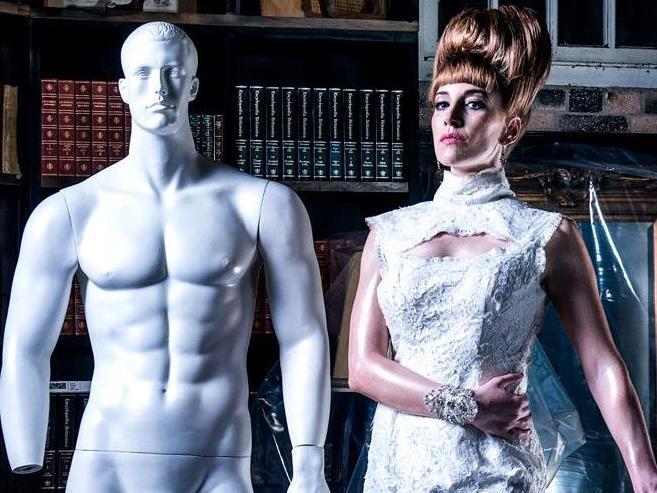Image by Dylan Evans.
La Boite and Brisbane Festival present Ibsen’s classic text, A Doll’s House, in a new adaption by Australian playwright, Lally Katz.
The narrative tells the story of Nora and her husband Torvald, who live in a seemingly perfect and undisturbed state of marriage. Torvald, while professing his love for Nora, is both controlling and patronising towards her, treating her like a doll and calling her his little ‘hummingbird’. Outwardly oblivious to her husband’s behaviour and its effect on her, Nora seems content to continue in this manner. But when a chain of events is set in motion, an act of forgery and deception is revealed in Nora’s past, leading her down a path towards her final emancipation from her rigid doll’s house existence.
A Doll’s House, although originally written in 1879, has much to offer modern audiences in its exploration of marriage, gender equality and female empowerment. The links between Nora and that of contemporary women is made overt towards the end of Katz’s adaptation in Nora’s departing polemic to her husband. While this speech is nothing new in terms of a modern feminist argument, it undoubtedly brings Ibsen’s narrative into the present and reminds audiences why A Doll’s House continues to be such a significant piece of work.
Director, Steven Mitchell Wright, has made some bold and interesting decisions regarding this performance which have enabled him to create a new and unique portrayal of Ibsen’s widely performed text. The highly stylised movement, the gothic aesthetic and the complete absence of any real interaction between the characters, all creates a highly dynamic and fascinating piece of stage craft.
However, while some of these choices are excellent for building an impressive performance aesthetic, in terms of creating a deep sense of story, they fall flat. The lack of eye contact and physical interaction between the characters, while being an excellent device to demonstrate the fragmented relationships, becomes frustrating to watch and prevents the audience from developing their own sense of connection to the characters or the story. There is also an abrupt clash of style and genre within the performance that is jarring and disconnected. The loud contemporary music in the second interval for example, arrives unannounced and unexpected and feels like an unnecessary conclusion to the act that preceded it (and the one that came after). Likewise the use of song; while injecting humour and lightness into the performance, feels as though it doesn’t quite belong here.
Helen Christinson is excellent throughout as Nora. However, the character’s submissiveness is exaggerated into a high state of (for want of a better word) ‘ditziness’ until the very end and her journey towards self-empowerment seems to happen in a great rush in the final few minutes. The result is that is that it isn’t quite believable and the depth of the moment is therefore lost.
While the cast are excellent in their respective roles, and perform the stylised routines extremely well, Damien Cassidy steals the show here as Dr Rank. This is partly to do with his fantastic gothic costume and make up, but should also be credited to Cassidy’s engaging physical and vocal portrayal of what can otherwise be a rather uninteresting character.
The set is also a highlight of this show, although again the audience experiences a clash of style with the gothic theme on stage. Additionally, the revolving stage along with the twisting of the ‘doll’s house’ strings and the lopsided chairs were all really fascinating, however I wanted these to be explored further within the performance.
At almost three hours and with two intervals, this performance really is too long and the interest that is generated by the look and feel of the piece is somewhat negated by the slow pace. However, despite the challenges of the show, it is a really unique twist on a well-known play and festival audiences will benefit from the accomplishments of this performance.
Rating: 3 out of 5 stars
A Doll’s House
Adapted by Lally Katz
Director: Steven Mitchell Wright
Designer: Dan Potra
Lighting Designer: Ben Hughes
Composer & Sound Designer: Dane Alexander
Wardrobe Co-ordinator: Nathalie Ryner
Stage Manager: Eloise Grace
Assistant Stage Manager: Kiralee Brill
Costume Makers: Millie Adams, Bianca Bulley & Michelle Wiki
Design Intern: Hahnie Goldfinch
Design Secondment: Vilma Mattila
Production Secondment: Teri Steer
Lighting Secondment: Matthew Milne
Production Manager: Don Mackenzie
Head Electrician: Keith Clark
Set Construction: Andrew Mills
Lighting Operator: Tim Gawne
Photography: Dylan Evans
Cast: Chris Beckey, Damien Cassidy, Helen Christinson, Cienda McNamara, Hugh Parker
Roundhouse Theatre, Kelvin Grove
Brisbane Festival
www.brisbanefestival.com.au
6 – 27 September





